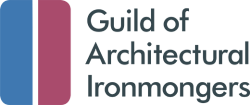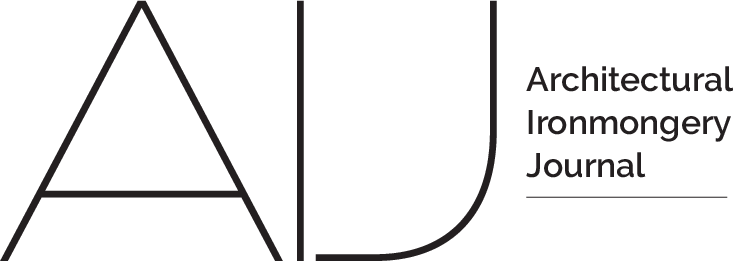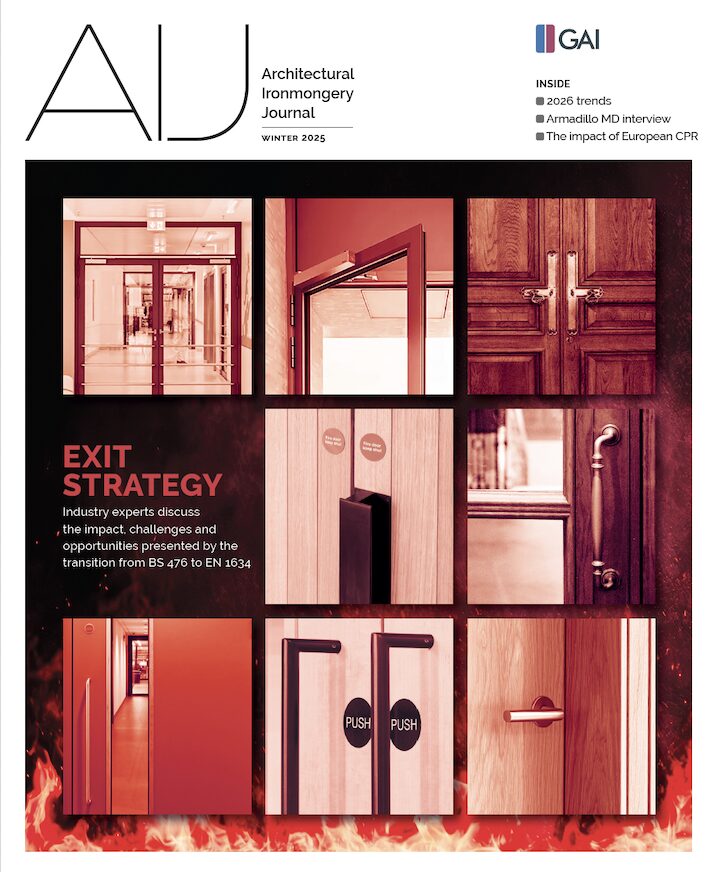Use AIJ to build your brand
Today more than 300 companies across 27 countries are members of the GAI and more than 2,500 people hold the globally recognised GAI Diploma. Join today and take your company to the next level.
GAI members offer significant market penetration of the vast bulk of AIs in the UK, both those who specify products, and those who sell it directly.
| ✔ The UK doors market size was valued at USD 4.8 billion (£3.62 billion) in 2024 by Global Market Insights# ✔ The UK fire doors and partitions market generated a revenue of USD 736.1 million (£554.3 million) in 2024 and is expected to reach USD 1,268.6 million by 2030 according to Horizon ✔ GAI in association with AMA Research discovered that the approximate percentage value of ironmongery to doors is 25% of the value of a complete doorset or assembly. ✔ This puts the value of the ironmongery market on doors generally at £1.2 billion and specific to fire doors at £138.6 million To reach this hugely important audience, use AIJ. Plus we offer: ✔ Architects and members of the CIAT (Chartered Institute of Architectural Technologists) ✔ A further 30,000 construction professionals through our industry partners |
You can reach these audiences three ways:
THE MAGAZINE AIJ is the only title to cover this extremely important sector of the building and construction industry. Published quarterly, AIJ is distributed to named individuals who represent the senior management and buyers of merchant and manufacturing companies AND the specifiers and senior partners in UK architect practices.
THE WEBSITE carries news, features, updates and also, every quarter, the latest digital edition of AIJ. Promoted to all recipients of AIJ the website is accessible at: www.aijmagazine.co.uk
THE AIJ EMAIL NEWSLETTER, the newsletter not only targets the recipients of the print version, but is also now delivered to members of the CIAT (Chartered Institute of Architectural Technologists) ensuring AIJ has an even wider reach. The average open rate of the enewsletter is 24% which shows that the industry responds well to more regular updates via email.
Contact our commercial team
If you’d like to advertise or sponsor one of our range of commercial opportunities, please contact David Smith. Tel: 07703532605 or email david,[email protected]
Advertising Policy & Code of Practice
Advertising Policy
- Content
All advertising in AIJ and associated publications (website, e-shots etc.) must be relevant to the architectural ironmongery, building design, construction or related sectors. The GAI reserves the right to exclude advertising on the grounds of lack of relevance, or incompatibility with the GAI Constitution and Mission, or non-compliance with the code of practice (as detailed in 2).
2. GAI Membership
The GAI actively encourages member companies to promote their membership through the inclusion of the relevant GAI logo(s) in their adverts. The correct membership category logo must be used at all times (and not the GAI’s own logo) in accordance with the brand guidelines contained in the GAI website Member Hub.
3. Non-Compliance
The GAI reserves the right to examine the validity of all advertisements and other material submitted for use in its publications prior to publication, to ensure compliance with its advertising policy and code of practice. In the event of a non-compliance being discovered after publication, a correction will, at the discretion of the GAI, be published at the first available opportunity.
4. Editorial Independence
Advertising bookings will not be made contingent on editorial coverage, not will editorial be subject to advertiser influence. See our editorial policy for more details on editorial submissions.
5. Cancellation
The GAI is not obliged to stop or cancel any advertisement in the AIJ unless it or its agents receive the requisite notice in writing, not less than 28 days prior to the proposed publication of the advertisement which the advertiser wishes to stop or cancel.
The following costs remain due on cancellation, and the advertiser acknowledges that these charges represent a genuine pre-estimate of the publisher’s losses:
- Notice of cancellation received 15-27 days before first publication: 50% plus VAT of total booking fee due.
Notice of cancellation received 0-14 days before first publication: 100% plus VAT of total booking fee due. - The GAI reserves the right to charge the full booking fee due, plus VAT for the cancellation of any Advertisement placed by the Advertiser if notice is not given in writing.
Code of Practice
This Code of Practice for Advertisers relates to the making of claims of compliance with the many performance standards that now exist for architectural ironmongery products. Its application is mandatory in relation to GAI publications, and companies are recommended also to use it when preparing their own literature, catalogues, websites and other publicity material.
Validity of claims
All claims made for products must be truthful and capable of validation, as detailed below.
BS EN ISO 9001: 2008
This is NOT a product standard and claims of compliance with this standard for a particular product cannot be made. It is an International Standard for assessment of management capability and the effectiveness of quality systems. Claims of conformity may be made only for the production facility at which the product was made.
Tests to BS and BS EN Product Performance Standards
All claims of compliance must be capable of being substantiated by valid test evidence. All the requirements of the standard must have been passed.
January 2014
Wording such as “tested to…” “designed to conform to…”, “approved to…”, “meets the requirements of…..” are potentially misleading and should not be used.
To avoid misleading or confusing claims, it is recommended that this sort of phrasing is used when claiming conformity: This product has been successfully type-tested for conformity to all the requirements of BS EN xxxx. Test reports and/or certificates are available upon request.
Evidence of Performance in Fire Tests
Fire and smoke door tests apply to complete door assemblies, not individual items of ironmongery. It is therefore not possible to claim compliance with any fire or smoke tests except BS EN 1634-2. It is possible to state “this widget has been incorporated in a (series of) fire test(s) to BS (EN) zzzz in conjunction with [a specific type(s) of] doors and frames”
CE Marking
CE Marking of certain products, when placed on the market for use on fire/smoke doors and doors on escape routes, is currently recommended by the GAI as a method of showing compliance with the essential requirements of the Construction Products Regulations Act 1991. CE Marking of these products is expected to become mandatory in the UK within the next 5 years. The GAI therefore only accepts advertisements for the following products where they are CE Marked and where the producer can provide a Declaration of Conformity.
- Emergency exit hardware – BS EN 179
- Panic exit hardware – BS EN 1125
- Hinges – BS EN 1935
- Door closing devices – BS EN 1154
- Emag door closing devices – BS EN 1155
- Door coordinators – BS EN 1158
- Mortice locks – BS EN 12209
- Electromechanically operated locks – BS EN 14846
Compliance with the DDA
A number of advertisements are submitted claiming that products are:
“DDA compliant!” “Fully comply with the DDA” “Opening forces comply with Approved Document M” “Complies with the requirements of BS8300” or simply carry the disabled logo with the hope the reader will infer the product is “DDA compliant”.
None of these statements are factually or technically correct and should not be made. It is the complete doorset and the associated hardware that may comply with the requirements of BS8300 and the guidelines contained within the Approved document M and not any single element of hardware.
Use of the following statement is therefore recommended: “These (products) can meet the opening force recommendations of BS8300 and Approved Document M. However, consideration must be given to the door width, other installed hardware and differential air pressures within the building to ensure they still meet the recommendations in situ”.
Certifire
The Certifire scheme for architectural ironmongery requires initial type testing of products, ISO 9001 Registration, a design appraisal to the relevant Certifire technical specification, inspection and surveillance of factory production control and audit testing of the product. Claims of Certifire Approval must correlate with the details shown on the Certifire Register at www.warringtonfire.net/certifire
Kitemarking
The British Standards Institution runs a third-party accreditation scheme for some product groups. This is the Kitemark and it requires initial type testing and regular ongoing third-party testing to be satisfactorily undertaken. Claims that reference this mark must be substantiated with current evidence.
Other product performance standards
There are only a few architectural ironmongery products which do not have matching BS or BS EN product performance standards available. Therefore, the GAI requires that all product performance claims reference national BS or EN standards, where such standards exist. Reference to other standards that may exist outside the EU is permissible only in the absence of a relevant UK or EU standard.
Self-certification
The GAI accepts that some producers have their own “in house” test facilities and it is acceptable for these tests to be referenced so long as it is clearly shown that these tests have NOT been carried out by a third party or in UKAS accredited test facilities, where this applies. “In house” test results generated in unaccredited test facilities must not be presented as equivalent to accredited third party–generated data.


